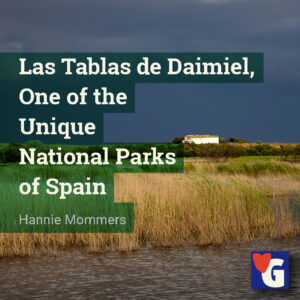
When I was doing the research for information about National Park Las Tablas de Daimiel, I realized this again is an article about a swamp. Like Insel Hombroich in Germany is a swamp. And that, while I really love all kinds of landscapes. 🙂
I have to admit that once we adore a place – be it a city, a museum or a landscape – we tend to revisit it often. In a museum the temporary exhibitions will be different each time. A landscape changes with the seasons and with the type of weather that can be extremely different in some years.
We went back only a few months after our 2017 visit to experience the difference of the Tablas after 2 months of excessive rainfall. And different it was!
Table of contents
Las Tablas de Daimiel

Going to the South from either Toledo (130km) or Madrid (185km), off the highway and somewhat hidden, you’ll find Las Tablas de Daimiel. It’s a small park, easily accessible even for wheelchairs and strollers.
The Tablas de Daimiel is one of the last examples of a flood plain region, locally called tablas. This phenomenon occurs where 2 rivers meet – in this case the River Cigüela with the River Guadiana.
This created a wetland, favored by the area’s flatness, that became one of the most important wetland ecosystems in the Iberian Peninsula for the survival of birds that use this refuge as an area for wintering, nesting, and migration.
Endangered wetlands
In an effort to dominate the soil, a plan for the drainage basin of the Guadiana, Cigüela, Záncara and their tributaries began in the 1960s. About 200 km of river was canalized, which meant almost extinguishing the associated shallow beds and floodplains.
In addition, agriculture in the area changed. Instead of cereal, olives and grapes, crops that do not need to be irrigated, they switched to much more water needing beet and maize. This caused the groundwater level to drop dramatically and dried the underground wells.
A small part of this unique landscape has been preserved when Las Tablas de Damiel was founded in 1973, but looking at it with our lay eyes during our regular visits, we certainly get the impression that the abstraction of water is still ongoing. Such a pity, don’t you think?
Accessibility
The park itself is easy to walk into, getting there is a bit more complicated. There is no public transport and it’s quite far from the highways. So the best way to get there is either by car or in an organized tour.
There is no fee required to enter the area. At the parking lot are a couple of buildings: a shop, a small visitor center and toilet block. Maps are available with hiking paths. You don’t actually need one, because there are 3 paths and you can’t leave them, but it’s nice to see where you are going.
And you’ll get some extra information. Which is especially nice if you are a bird watcher. Scattered around the park are several bird watch houses with a view on the water (if there is water).
Facilities
If you are desperate for a cup of coffee or a meal you’d better take it a couple of kilometers before entering the park in Restaurante Mesón de La Duquesa. The shop at the entrance of the park has only some bottled water and sweets.
Next to the restaurant is also an old mill with another visitor center. From here you can participate in guided tours. Those are either by foot or in a 4×4. I can’t tell anything about those, because we are the kind of tourists that prefer to wander around by ourselves.
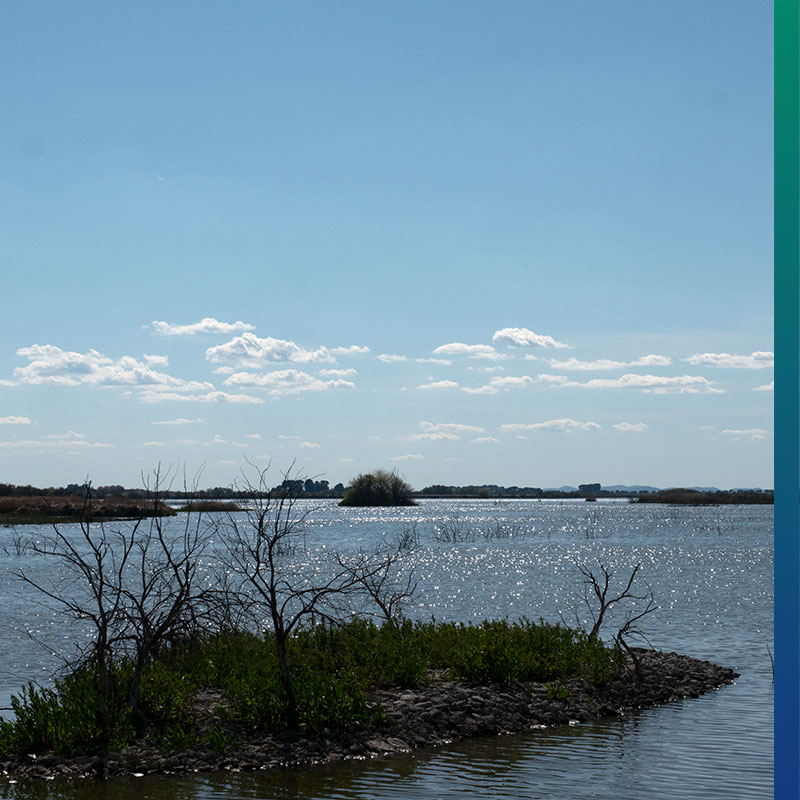
Facts about the area
- National Park: since 1973.
- Location: Carretera a las Tablas de Daimiel, s/n, 13250 Daimiel, Ciudad Real, Spain.
- Acreage: 3.030 hectares. Surface area of the buffer zone: 4.337 ha.
- Average altitude: 606m. As it is on the large Mancha plain, there are no significant changes in height. The lowest point is the course of the River Guadiana, between 603 and 604 m, the highest is the observatory on the Island of Pan, about 610m.
- Climate: Continental temperate climate with a dry season, characterized by cold winters with extreme temperatures of -10ºC and hot dry summers with maximum temperatures reaching above 40ºC. Mean annual precipitation of 400mm.
Nature preservation: National Parks
Spain owns 10 national parks on the Iberian Peninsula. Until now, we have visited half of them, leaving us enough to have on our bucket list. In alphabetical order:
- Aigüestortes i Estany de Sant Maurici*;
- Cabañeros*;
- Doñana*;
- Islas Atlánticas de Galicia;
- Monfragüe;
- Ordesa y Monte Perdido*;
- Picos de Europa;
- Sierra de Guadarrama;
- Sierra Nevada;
- Tablas de Daimiel*.
With 3.030 hectares Tablas de Daimiel is the smallest. The biggest national park is the Picos de Europa, with 67.128 hectares it’s also the first Spanish national park, established in 1918. Besides the national parks there are also a lot of regional parks in Spain worth a visit, such as the Delta de Ebro, Sierra Espuña (where we live – look at the arrow with the heart) and Cazorla.
Other things to visit in the area
Usually we spend half a day in Las Tablas. Always when going from one place to another. There are sleeping facilities in the neighborhood, called Casas Rurales. We haven’t tried these yet. At the time of our first visits our son lived about 150 km up north and nowadays we live 350 km to the south from the park.
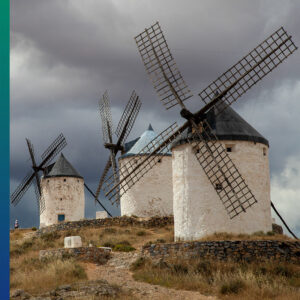
- Definitely worth a visit and close by – 55 km which will be a 1-hour drive – are the Don Quixote mills, Los Molinos de Viento de Consuegra. You’ll find more of these typical Spanish mills all over the country, but here are 12 and they are beautifully restored.
- Fuente el Fresno (along the N-401 from Toledo to Malagón). Just before you drive across the city limits, you can leave the N-401 to your right and you will immediately see a signboard with walking routes. From there one of the famous Caminos del Colesterol starts.
- Halfway off the N-430 from Daimiel to Manzanares you can visit the Motilla del Azuer. This is the most important archeological site from the Bronze Age in La Mancha (2200-1300 BC).
I will save the information about those sites for another article. 🙂
Tell me, have you ever heard of Las Tablas de Daimiel before? Please put your answer, or if you have any questions, in the comment box below.
Wouldn’t it be marvellous to make some extra money by doing something you truly enjoy? Like travelling and writing about it? Become a member of Wealthy Affiliate and start your own website about your favourite places.

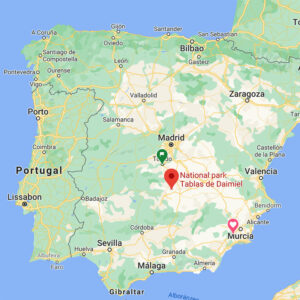
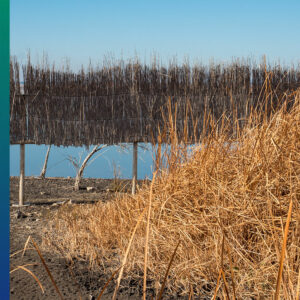
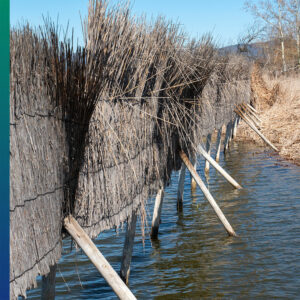
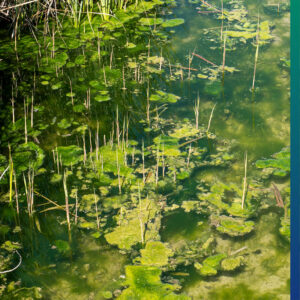
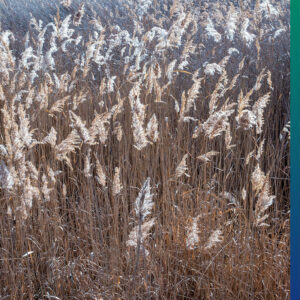
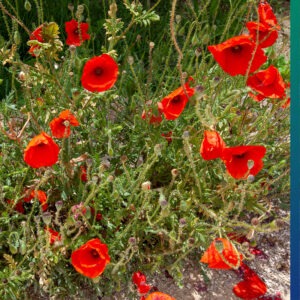
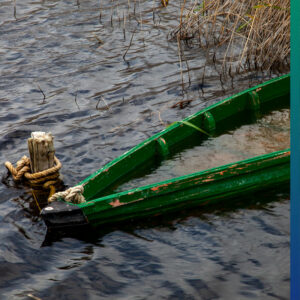
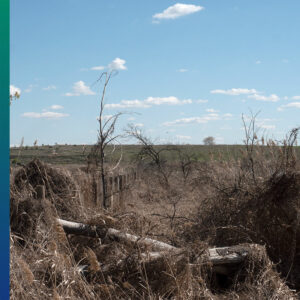
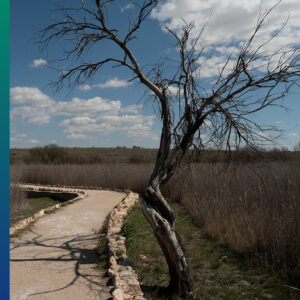
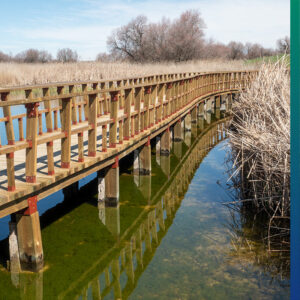

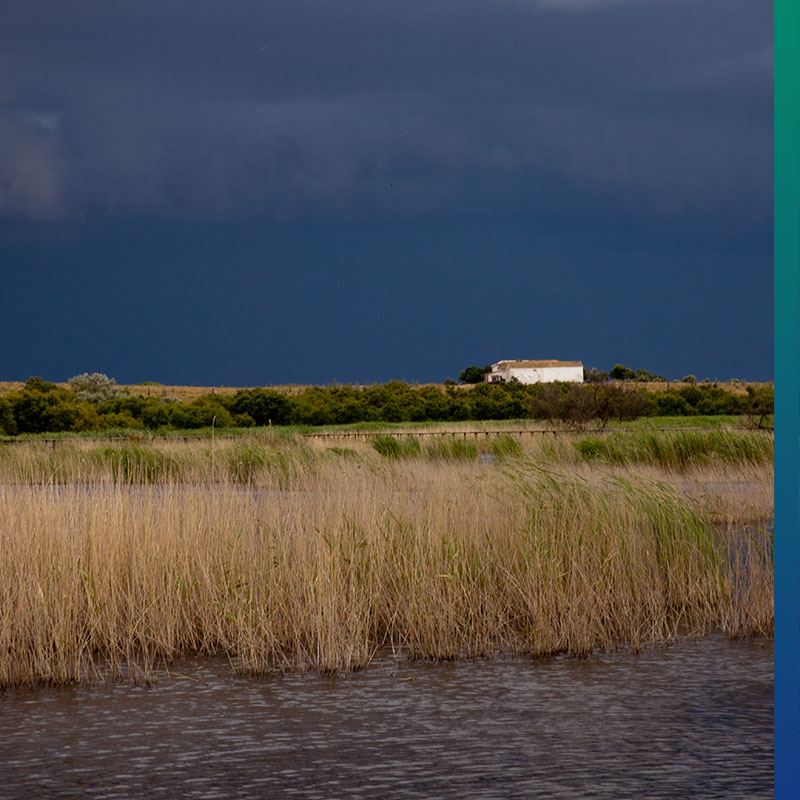


I have never heard of Las Tablas de Daimiel before, but it looks beautiful and I would love to visit it one day. I have been to Spain before, a few times, but there are still so many places I need to see there. Swamps have something special, I think, certain mystery mixed with romance, and judging by the photos Las Tables looks like a great place to go for a walk. I’m like you, I prefer to just go without having a guide ramble on and on next to me. I prefer to do my research and just explore the area on my own 🙂
You and me both, Christine. I am so glad we visited Ordesa and Aigüestortes years ago, because nowadays you are not allowed anymore to enter on your own and whenever you want. I do understand the necessity of that rule, they have to regulate the number of visitors in order to preserve the nature for future generations as well. But I am not the patient type, waiting until the bus arrives, bide the time see if there is enough space left in the bus, hiking with one eye on your watch in order to get back in time for the return journey. Traveling and hiking for me is having a sense of freedom. Which is gone in overregulated areas.
Hi Hannie,
I’m sure you know by now that I always appreciate beautiful landscapes, and hiking around them.
With that said, I’m not particularly a fan of walking/hiking in hot weather (is anyone?)
So, I know that to visit and enjoy Las Tablas de Daimiel I’d have to go at the right time of the year.
This would probably being during the Spring or Autumn months for me.
I can see from your photos that much of the last decade’s extremely high temperatures across Europe (and especially Spain) has dried out much of the park.
This is a shame.
However, just looking at your photo of the flowers in bloom in 2011 looks lovely, and that’s the kind of thing I really enjoy seeing on my various hikes.
I don’t know if you feel the same, but I know whenever I’m out in nature, taking in my surroundings, just seeing beautiful scenery has such a calming and “happy” effect on me.
Your picture of the wetlands back in 2018 also looks awesome.
I’ve also voted in your “most attractive landscape” and I don’t mind sharing that I opted for the hills.
I love walking around beautiful landscapes, but I also prefer to get some decent exercise while I’m doing it.
For me, hills and steep gradients will always win the day, as I’m not quite into my mountain climbing just yet.
It’s also great to hear that during your time in Spain that you’ve already visited half of the National Parks.
I’m guessing Picos de Europa has to be on your bucket list, as well as mine.
Sounds fantastic.
Partha
Tom would definitely disagree with your remark about hot weather, but I do. Some parts of Spain, even where we live, are way too hot in summer. You skipped winter in possible seasons to visit and I am not sure that’s justified. We visited Daimiel several times during the winter season and although the wind can be fiercely cold it was lovely to hike then.
Unfortunately, it’s not just the high temperatures that cause the park’s drought, Partha. Agriculture in that area is the main culprit. And you can rightly say that poisoning from agriculture causes the higher temperatures, but it is also the choice of water-intensive crops that have a negative effect on the groundwater level.
If you look at this article of El País you can read about the inability of the organizations not only to establish but also to comply with the correct regulations. (If you open the article in Chrome it’s easy to translate it to English!)
Oh yes, I voted for the hills as well. Mainly, by the way, because of the visual aspect. 🙂
I love those gentle slopes and that greater sense of space due to the slopes behind each other more than the overwhelming view of angular, high mountains.
Picos de Europa is definitely on my bucket list. Those would probably be great to visit in the summer, because Galicia is much cooler than the south of Spain.
Hi Hannie,
This is a wonderful post about Las Tablas de Daimiel. If I am being honest I know very little about Spain and the rest of Europe’s national parks, though I’ve long wanted to travel across Europe. I’ve also never really thought about visiting national parks while on that trip but after reading your article that is something I REALLY want to do. Are there any other national parks you might recommend? Thanks for the great post!
Hi Dev, it may be obvious I love national parks. 🙂 So yes, I can recommend some:
Another one here in Spain is Cazorla. It’s a long stretch of a forest with a river. Beautiful campgrounds and an amount of hiking paths that are not too difficult to walk on.
If you plan a European visit than the Italian Monte Sibillini and the Abruzzo are worth a visit. And in the Netherlands the Hoge Veluwe and the Waddenzee which I have described in an article.
Personally I love the combination of culture and art the most. That’s why I am a raving fan of the Hoge Veluwe with its nature and museum of modern art.
Have a great trip once you get to Europe. 🙂
Hello Hannie
Who knew that place existed? Much of it reminds me a bit of the Norfolk Broads in England which is very similar (except for the weather!)
Isn’t the bird life wonderful? It must be a bird watchers paradise. Thanks so much for sharing. The more I learn about Spain the less I realise I know!
Next time I am planning a trip I will re-visit your site!
Best,
Jean
Looking at pictures on the internet of the Norfolk Broads they seem to me a lot wetter than Daimiel, but I can definitely see what the resemblance is. Great to have that to put on my list for England, Jean, thanks!
Some Greek philosopher already said, the more we learn, the more we realise we don’t know enough. So I can imagine your feeling about not knowing Spain at all. As I know hardly anything about England and Scotland. But that is the beauty of the internet, isn’t it, that we inspire each other to discover all these wonderful places . 🙂
Spain, the place where my daughter would like to visit. Never head about Las Tablas de Daimiel what a beautiful place to visit and walk around. Never visited a national Park before I started to camp in one in Ottawa, those parks are worth to visit. Thank you for sharing I enjoy reading your post.
Lyne
Hi I love you post on Las Tablas de Daimiel. I have never heard of this place but it sounds amazing. The scenery is wonderful and if I ever visit Spain it would be on my bucket list.
My father often visited Spain and he would select a location and stay there for the summer months.
I love your photographs they are so beautiful.
In which places did your father stay, Yvonne? It’s a great way of traveling to stay in a location for a while, instead of rushing from one hot spot to the next. Discovering the area and sort of experiencing it in a calm way. Lovely!
Thanks for the compliments on my pictures. I love taking pictures as is obvious. 🙂 That too is a way for me to observe the whole scenery and its details. It adds a lot of fun at the time itself, but also later when I browse through them.
Hey Hannie, that’s a beautiful landscape indeed. I went to Madrid quite a few times to do business, but I never realized that Spain has such a beautiful landscape. I mean: I assumed, but when you go there for business trips, you usually won’t see much more than your hotel room, a conference room and maybe a bar in the evening, right? So that was a really nice “trip” beyond Madrid for me! Thanks for sharing!
After you’ve been there twice (correct, right?) do you have a favorite season to go there?
Cheers,
chris
You’re right, Chris, if you go for business your mind is set to something else than sightseeing. Unless there is a possibility to add a few days to a trip. Which can’t always be done. And yes, Spain has beautiful landscapes, and a lot of variety.
I have been 4 or 5 times to Las Tablas de Damiel, I lost count. And I prefer the late Spring. Too early everything is still yellow. Too late it’s getting too hot to my liking. In late Spring the weather is beautiful and chances are high there still is water, if there were enough rain showers during Autumn and Winter.
But overall I like every season in the park. It has such a difference of color and variety of plants growing in the different seasons. And although it might not show enough in the pictures, that one time we were there when there was a storm coming in, it was beautiful to look at the clouds.
Often we can get so entangled in the rat race that we forget to take a moment to open our eyes, look around us and appreciate and enjoy the beauty that mother nature has to offer. The beauty of the outstretched landscapes with its beautiful fauna and flora and the majestic mountains casting its shadows over a water stream or two.
No exceptions here when it comes to the beauty of the wetlands of Las Tablas De Daimiel and a real bird watchers paradise too.
It is on my bucket list to start travelling Europe soon. Born in sunny South Africa and now living under the cloud of the UK, I always long for those hot summer days and Las Tablas De Daimiel may just become my very next destination.
I can imagine you long for sun, given the differences between South Africa and the UK. I wasn’t even born in a sunny country (the Netherlands), but am so happy to be living here in Spain now. The sun does wonders for my mood.
Yes, emerging yourself in nature has a lot of benefits. More and more research shows how beneficial it is for us to be in nature often. I wrote about it as well in this article: Walking for Health Benefits that will Reward You Immediately. If you feel trapped in the rat race, than go outside. Even for 10 minutes. 🙂
Dear Hannie,
This is really beautiful! I had no idea that Spain has so many National parks. Your photos give an excellent impression. When you said that the temperatures are around min 10 degrees in winter, I was amazed. I mean, here in the Netherlands we don’t reach that anymore. I only know a little about the Northern part of Spain. Now I feel invited to go and travel to this beautiful country. Your article is making me want to visit the parc. I shared it on FB and Twitter!
Thanks so much for the sharing, Sylvia. Yes, Spain has so many landscapes, it’s really great to travel around here. 🙂
The middle of Spain is a highland (above 600m) and has a continental climate in contrast to the Netherlands that has an oceanic climate. So that means very hot summers and very cold winters. Although I do remember winters in the Netherlands when I was a kid with temperatures between -15 and -20 degrees C. It often made me vomit, that cold! Needless to say I don’t like the cold very much, LOL.
It’s often worthwhile to look for lists of National Parks if you are visiting a country. And if there are no National Parks in the region where you will be, some Regional Parks are great as well. For instance the park at which foot we live is Regional Park Sierra Espuña and it is totally different from Las Tablas de Daimiel, which makes it really interesting to compare.